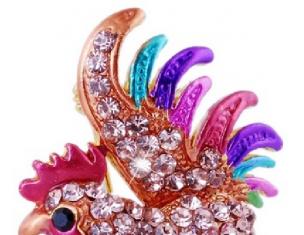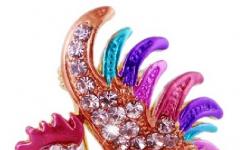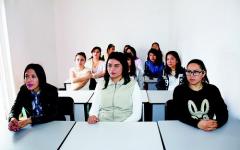Information taken from open sources. If you want to become a page moderator
.
Midwifery Institute
predyduschie_name:
Form of study:
State diploma of secondary vocational education
Certificate of completion:
Series 77, No. 003732, registration No. 030666, dated 03/06/2012, indefinitely
Licenses:
Series 77A01, No. 0000807, registration No. 000807, from 01/18/2013 to 01/18/2019.
Accreditations:
College characteristics
general information
The original educational institution, which later became Medical School 1, was the Midwifery Institute.
- In 1764, by Decree of Catherine II, an Educational Home was opened in Moscow on Solyanka, at which the first obstetric institution in Russia was opened, a maternity hospital with 20 beds, expanded 2 years later to 40 beds.
- In 1801, an educational institution was opened at the Maternity Hospital, which was called the Midwifery Institute. Its first director was Wilhelm Richter. The duration of study at the institute was 3 years. The students of the Midwifery Institute were initially recruited from the pupils of the Orphanage. The first course began classes on January 1, 1801. The first graduation from the institute was on December 21, 1803.
- In 1839, the Maternity Hospital and the Midwifery Institute were separated from the educational home into an independent institution and were located on Solyanka near the Ustinsky Bridge in a separate building, which for some time housed the Central Medical Assistant and Midwifery School. Subsequently, the maternity hospital was transferred to the building now occupied by the Institute of Pediatrics of the Academy of Medical Sciences. The entire building occupied by the Maternity Hospital remained behind the Midwifery Institute; classrooms and a dormitory were located in it.
- In 1842, the Midwifery Institute began to staff, in addition to the pupils of the Orphanage, “girls of all classes.” They were required to live in a dormitory. The Institute has ceased to be a closed educational institution.
- In 1859, courses were opened at the Midwifery Institute to train midwives “of the common rank.” They were sent to study at the expense of landowners from cities and counties. In 1901, the Charter of the Midwifery Institute was revised and approved by the Ministry of Internal Affairs and remained in the same form until the October Revolution. The October Revolution put the Protection of Motherhood and Infancy at the heart of everyday life and put forward new tasks for training workers in the Protection of Motherhood and Infancy.
- In 1920, the Midwifery Institute, together with the Maternity Hospital, was reorganized by the Department of Maternity and Infancy Protection into the Institute of Obstetrics, which is still located on Solyanka, 12.
- In 1923, all medical educational institutions came under the authority of the Glavprofobra and from that time on, instead of the Institute of Obstetrics, the Central Obstetric College emerged.
- In 1927, the Central Obstetric College merged with Central School sisters-pupils, organized in 1918 by the department of OMM NKZ into one educational institution - the Moscow Medical College, in which since that time there have been two departments - nursing and obstetrics. And since 1934, the nursing department was reorganized into the department of a pediatric assistant with a training period of 2.5 years. In the same year, the 100th graduation of the former Midwifery Institute took place. In 100 years, 10,000 midwives graduated from the school. At the ceremonial meeting, People's Commissar of Health N.A. Semashko delivered a greeting.
- On January 1, 1935, a paramedic department was opened at the Central Medical College; in the fall of 1935, it was reorganized into the Central Medical Assistant and Midwifery School of the People's Commissariat of Health, incorporating obstetric and medical assistant departments.
- In 1939, our school was joined by a dental school from 13 Nikitsky Boulevard, and in 1941 a regional dental school from 50 Pyatnitskoyd Street. From the very beginning of its foundation in 1801 until 1938, the school was located at Solyanka, 12.
- In 1938-39 The Moscow City Health Department rebuilt a 3-storey building for the Central Medical School at 25 Pavlovskaya Street, which houses the school to this day.
- In 1954, all medical schools were renamed into medical schools (pr. No. 12/66 dated 08/09/54 according to the Moscow City Health Department “On the renaming of medical schools into medical schools”).
The oldest Moscow medical school received number one. Over the past years, the school has trained more than 60 thousand specialists with secondary medical education in various fields (nurses, paramedics, paramedics, dentists, dental technicians, midwives).
More than 200 years have passed since January 1801, during which many different events, sad and joyful, took place in the country. But no matter what happened, graduates of medical school No. 1 lived and worked everywhere in Russia along with their contemporaries.
The historical traditions at the school are strong and are passed on from one generation of students and teachers to another. Therefore, it was in our school that the training of sisters of mercy was revived in 1990. This department became the basis for the organization of the independent St. Danilov School of Sisters of Mercy of the Moscow Health Committee, which was opened on June 20, 1992 by order of the Moscow Government with the blessing of His Holiness Patriarch Alexei II of Moscow and All Rus'.
 See all photos
See all photos
About the school
1 of




We train medical workers in 2 specialties:
◊ Nursing
◊ Orthopedic dentistry
The school has an excellent material and technical base: in classrooms equipped modern equipment, there is audio-video equipment, computers - everything necessary for a high modern level of student training, and this base is constantly modernized and updated.
Admissions Committee Contacts
Admission conditions
When submitting an application for admission, the applicant presents:
1. A document certifying his identity, a document certifying his citizenship;
2. The original state document on education or its certified copy (the copy is certified according to the original by the educational institution to which it is submitted, or in the prescribed manner);
3. 6 photographs size 3x4;
4. Medical certificate form 086u (indicating mandatory vaccinations, their series and date: ADS-m R3, measles Rv (revaccination), Paratitis Rv (revaccination), Hepatitis “B” V3, Rubella Rv (revaccination)).
5. A copy of the medical insurance policy;
6. A copy of the work book (if available).
7. Other documents may be presented to applicants if they are applying for benefits established by the legislation of the Russian Federation.
FOR CITIZENS OF RUSSIA AND CIS REGIONS IT IS MANDATORY TO HAVE REGISTRATION AT THE PLACE OF ARRIVAL!
- When submitting an application, foreign citizens present:
- a copy of the applicant’s identity document or identification document foreign citizen in the Russian Federation;
- the original of a state-issued document on education (or its duly certified photocopy), or the original of a foreign state document on education, recognized as equivalent in the Russian Federation to a state-issued document on basic general and (or) secondary (complete) general education (or its certified in accordance with the established procedure, a photocopy), if necessary, with a certificate of establishing its equivalence, or originals of a document of a foreign state on education legalized in the prescribed manner (if necessary) and annex to it (if the latter is provided for by the legislation of the state in which such a document on education was issued); - a duly certified translation into Russian of a foreign state’s document on education and its annexes;
- 6 photos size 3x4;
- a copy of the medical insurance policy;
- medical certificate form 086u (indicating mandatory vaccinations, their series and date: ADS-m R3, measles Rv (revaccination), Paratitis Rv (revaccination), Hepatitis B V3, Rubella Rv (revaccination)).
Persons with disabilities when submitting an application, submit an original or photocopy of the following documents:
. conclusion of the psychological, medical and pedagogical commission;
. a certificate of disability issued by the federal institution of medical and social examination;
Medicine
Medical support for students and students at the School is provided by full-time and assigned medical personnel, who, along with the administration of the Institution, are responsible for carrying out treatment and preventive measures, compliance with sanitary and hygienic standards, the regime and quality of nutrition for students.
Creation
Democratic governance provides the student body with the right to self-government in the general school community. Students actively participate in city events: “World Youth Day”, “We are faithful to this memory”, etc.
Tasks- formation in students of the need and desire to realize the five “self”: self-organization, amateur performance, self-government, self-education, self-education.
Thus, the functions and tasks facing the Student Council are important in the creation and development of the student body in the spirit of mutual assistance, friendship, and cooperation. Not only the education and development of students, but also the overall image of the school depends on the correct understanding and implementation of the tasks assigned to the Student Council.
Throughout the year, the Student Council of MU No. 1 takes an active part in all events held at the school and participates in their organization. Students also initiate and take an active part in city events, such as:
- "Initiation as a medical student"
- Festivals,
- Competitions,
- Participation in a creative team (celebratory events),
- Participation in charity events: Children's Home No. 17, Children's City Clinical Hospital No. 21, under the motto “Every child is dear to us”
The student council of the school is part of the district youth council under the Head of the Danilovsky District Administration of the Southern Administrative District of Moscow.
For many years, the school has successfully operated an advanced training department for nurses in infectious diseases hospitals and departments, treatment rooms, dental clinic nurses, dentists, and dental technicians.
Department of advanced training:
■ Nursing in dentistry
■ Nursing for infections
■ Modern aspects of orthopedic care to the population
■ Dental care for the population
License for implementation educational activities No. 036849 (issued by the Moscow Department of Education, Series 77L01 No. 0007658, December 7, 2015. Validity period - unlimited)
Certificate of State Accreditation Series 77 A01 No. 0004045 dated December 21, 2015 Valid until February 16, 2021.
Basic information
12/15/2015 on the basis of the order “On the reorganization...” of the Moscow City Health Department No. 499 dated 06/15/2015 State budgetary educational institution average vocational education of the city of Moscow "Medical College No. 1 of the Moscow City Health Department" was reorganized in the form of annexation to it:
- State budgetary educational institution of secondary vocational education of the city of Moscow "Medical School No. 4 of the Moscow Health Department"
- State budgetary educational institution of secondary vocational education of the city of Moscow "Medical School No. 5 of the Moscow Health Department"
- State budgetary educational institution of secondary vocational education of the city of Moscow "Medical School No. 19 of the Moscow Health Department"
- State budgetary educational institution of secondary vocational education in Moscow " Medical College named after S.P. Botkin of the Moscow City Health Department"
Information on the implementation of educational programs
I. Professional education:
02/34/01. Nursing
Form of study: full-time, duration of study educational program- 3 years 10 months (based on 9 classes).
02/34/03. Laboratory diagnostics
Form of study: full-time, duration of mastering the educational program - 3 years 10 months (based on 9 classes).
II. Additional education:
Additional education for children and adults:
Preparatory courses: for persons who have completed secondary school (complete) general education, as well as students of 9th, 10th, 11th grades of secondary secondary schools. Duration - 2 and 6 months.
Additional professional education:
- Professional retraining.
- Training
The original educational institution, which later became Medical School 1, was the Midwifery Institute.
In 1764, by Decree of Catherine II, an Educational Home was opened in Moscow on Solyanka, at which the first obstetric institution in Russia was opened, a maternity hospital with 20 beds, expanded 2 years later to 40 beds.
In 1801, an educational institution was opened at the Maternity Hospital, which was called the Midwifery Institute. Its first director was Wilhelm Richter. The duration of study at the institute was 3 years. The students of the Midwifery Institute were initially recruited from the pupils of the Orphanage. The first course began classes on January 1, 1801. The first graduation from the institute was on December 21, 1803.
In 1839, the Maternity Hospital and the Midwifery Institute were separated from the educational home into an independent institution and were located on Solyanka near the Ustinsky Bridge in a separate building, which for some time housed the Central Medical Assistant and Midwifery School. Subsequently, the maternity hospital was transferred to the building now occupied by the Institute of Pediatrics of the Academy of Medical Sciences. The entire building occupied by the Maternity Hospital remained behind the Midwifery Institute; classrooms and a dormitory were located in it.
In 1842, the Midwifery Institute began to staff, in addition to the pupils of the Orphanage, “girls of all classes.” They were required to live in a dormitory. The Institute has ceased to be a closed educational institution.
In 1859, courses were opened at the Midwifery Institute to train midwives “of the common rank.” They were sent to study at the expense of landowners from cities and counties. In 1901, the Charter of the Midwifery Institute was revised and approved by the Ministry of Internal Affairs and remained in the same form until the October Revolution. The October Revolution put the Protection of Motherhood and Infancy at the heart of everyday life and put forward new tasks for training workers in the Protection of Motherhood and Infancy.
In 1920, the Midwifery Institute, together with the Maternity Hospital, was reorganized by the Department of Maternity and Infancy Protection into the Institute of Obstetrics, which is still located on Solyanka, 12.
In 1923, all medical educational institutions came under the authority of the Glavprofobra and from that time on, instead of the Institute of Obstetrics, the Central Obstetric College emerged.
In 1927, the Central Obstetric College merged with the Central School of Nurses, organized in 1918 by the Department of OMM NKZ into one educational institution - the Moscow Medical College, in which from that time there were two departments - nursing and midwifery. And since 1934, the nursing department was reorganized into the department of a pediatric assistant with a training period of 2.5 years. In the same year, the 100th graduation of the former Midwifery Institute took place. In 100 years, 10,000 midwives graduated from the school. At the ceremonial meeting, People's Commissar of Health N.A. Semashko delivered a greeting.
On January 1, 1935, a paramedic department was opened at the Central Medical College; in the fall of 1935, it was reorganized into the Central Medical Assistant and Midwifery School of the People's Commissariat of Health, incorporating obstetric and medical assistant departments.
In 1939, our school was joined by a dental school from 13 Nikitsky Boulevard, and in 1941 a regional dental school from 50 Pyatnitskoyd Street. From the very beginning of its foundation in 1801 until 1938, the school was located at Solyanka, 12.
In 1938-39 The Moscow City Health Department rebuilt a 3-storey building for the Central Medical School at 25 Pavlovskaya Street, which houses the school to this day.
In 1954, all medical schools were renamed into medical schools (pr. No. 12/66 dated 08/09/54 according to the Moscow City Health Department “On the renaming of medical schools into medical schools”).
The oldest Moscow medical school received number one. Over the past years, the school has trained more than 60 thousand specialists with secondary medical education in various fields (nurses, paramedics, paramedics, dentists, dental technicians, midwives).
More than 200 years have passed since January 1801, during which many different events, sad and joyful, took place in the country. But no matter what happened, graduates of medical school No. 1 lived and worked everywhere in Russia along with their contemporaries.
The historical traditions at the school are strong and are passed on from one generation of students and teachers to another. Therefore, it was in our school that the training of sisters of mercy was revived in 1990. This department became the basis for the organization of the independent St. Danilov School of Sisters of Mercy of the Moscow Health Committee, which was opened on June 20, 1992 by order of the Moscow Government with the blessing of His Holiness Patriarch Alexei II of Moscow and All Rus'.
schedule Operating mode:
Mon., Tue., Wed., Thu., Fri. from 10:00 to 17:00
Latest reviews
Natalia I 09:46 07/12/2015I just finished my evening at this college. The impressions are terrible. The quality of training is almost zero, as is the organization of the training process. The administration believes that the student is obliged to pay money on time and no one owes him anything - for example, no one is obliged to promptly report the availability and dates of exams and practice and other useful information. All communication takes place according to the principle - “the headman accidentally called the “curator” and they shouted at him that everyone should immediately, urgently!
Gallery



general information
State budgetary professional educational institution of the Moscow Department of Health Medical College No. 1
License
No. 3684 valid indefinitely from 12/07/2015
Accreditation
No. 4045 is valid from 12/21/2015 to 02/16/2021
About the college
A state educational institution appeared in Moscow in 1951 with the status of a medical school. The main task of the Medical School No. 14 that existed at that time was the systematic special training of former front-line nurses. In 1972, the school became the basic medical educational institution in Moscow; obstetricians, nurses, paramedics and laboratory assistants were trained here. Since 1980, a methodological office appeared within the school, whose employees, who were also teachers at the school, supervised the work of city methodological commissions throughout the capital. In 1991, for the first time in Russia, a medical college was organized on the basis of the school. In 2011, the educational institution celebrated the 60th anniversary of its establishment and the 20th anniversary of its new legal status.
Over 60 years of operation, the college has trained about 18 thousand qualified specialists with medical education. Today the college trains specialists in general medicine, nursing, and midwifery. There is a choice between basic and advanced professional training profiles. Certified specialists with a medical education can study at the college under professional retraining programs, courses in laboratory diagnostics, medical and pediatric massage. The training of registered nurses at the school for introducing nursing innovations into public health is gaining popularity. The admissions committee operates from June 1 to August 25; during this period, citizens of the Russian Federation and the CIS can submit an application for admission as a student and the original of their existing education document. Admission is based on a competition of certificates. Possibility of training is allowed on a commercial basis in case of non-compliance with the requirements for applicants for training at the expense of the federal budget.
Theoretical training of medical students is carried out by professional teachers who have extensive experience in the medical environment. During professional training, students master both special and general professional blocks of disciplines. A high level of professional competence of college teachers and their serious creative potential are the main conditions for the quality of training of specialists with medical education. The applied specificity of education is of great importance in the secondary specialized training of medical personnel. The practice bases for students of Medical College No. 1 are the following state medical institutions: city clinical hospitals No. 36, 50, 59, 86, infectious diseases clinical hospitals No. 1, 2, maternity hospital No. 27, hospital for war veterans No. 3, and There are also numerous scientific centers in the capital.
The college has an active student council, which is the central body of student government. The headman system also works very effectively; group heads are awarded personal scholarships for social activity. The hostel provides places for students specializing in secondary vocational education. For students under programs professional retraining and advanced training at the hostel is not provided. Students are provided with support to continue their education in higher education educational institutions, and for graduates – in employment.









